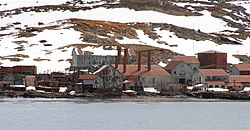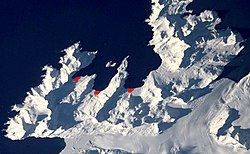Leith Harbour: Difference between revisions
Created page with ':''Not to be confused with the Port of Leith in Midlothian'' {{Infobox town |name=Leith harbour |territory=South Georgia and the South Sandwich Islands |picture=Leith whalin…' |
mNo edit summary |
||
| Line 2: | Line 2: | ||
{{Infobox town | {{Infobox town | ||
|name=Leith | |name=Leith Harbour | ||
|territory=South Georgia and the South Sandwich Islands | |territory=South Georgia and the South Sandwich Islands | ||
|picture=Leith whaling station.JPG | |picture=Leith whaling station.JPG | ||
Revision as of 15:07, 3 August 2014
- Not to be confused with the Port of Leith in Midlothian
| Leith Harbour | |
| South Georgia and the South Sandwich Islands | |
|---|---|
 Part of the abandoned whaling station at Leith Harbour | |
| Location | |
| Location: | 54°8’28"S, 36°41’17"W |
| Data | |
| Local Government | |
Leith Harbour, also known as Port Leith, is an abandoned whaling station on Stromness Bay in the middle of the north coast of South Georgia. It is one of three whaling stations on the bay, along with Husvik and Stromness.
Leith Harbour was established and operated by Christian Salvesen Ltd of Edinburgh. It was in operation from 1909 until the end of whaling in 1965 and was the largest of seven whaling stations, situated near the mouth of Stromness Bay. One man prominently involved in setting up Leith Harbour was William Storm Harrison.
The station is named after Leith in Midlothian, the port of Edinburgh, where Christian Salvesen Ltd was based.
History



South Georgia was once the world's largest whaling centre, with shore stations at Grytviken (operating 1904-64), Leith Harbour (1909-65), Ocean Harbour (1909-20), Husvik (1910-60), Stromness (1913-61) and Prince Olav Harbour (1917-31). The Japanese companies Kokusai Gyogyo Kabushike Kaisha and Nippon Suisan Kaisha sub-leased Leith Harbour in 1963-65, the last seasons of South Georgia whaling.
In 1912 Leith Harbour was the site of the second introduction of reindeer to South Georgia, an attempt which failed when the entire herd was killed by an avalanche in 1918.
During the Second World War the whaling stations were closed excepting Grytviken and Leith Harbour. Most of the British and Norwegian whaling factories and catchers were destroyed by German raiders, while the rest were called up to serve under Allied command. The resident Magistrates (W Barlas and AI Fleuret) attended to the island’s defence throughout the War. The Royal Navy armed the merchant vessel Queen of Bermuda to patrol South Georgian and Antarctic waters, and deployed two four-inch guns at key locations protecting the approaches to Cumberland Bay and Stromness Bay, protecting to Grytviken and Leith Harbour respectively. These batteries (still present) were manned by volunteers from among the Norwegian whalers who were trained for the purpose.
Falklands War
The Falklands War began at Leith Harbour. It was precipitated when in March 1982 a group of around fifty Argentines, posing as scrap metal merchants, occupied the abandoned whaling station at Leith Harbour. They were understood to have a commercial contract to remove scrap metal at Leith Harbour but they arrived aboard a ship chartered by the Argentine Government. On 25 March 32 special forces soldiers were brought by the Argentine Navy ship Bahía Paraiso to South Georgia and landed at Leith Harbour on 25 March 1982.
On 25 April 1982 the Royal Navy damaged and captured the Argentine submarine Santa Fé at South Georgia. The Argentine garrison in Grytviken surrendered without returning the fire and so did on the following day the detachment in Leith Harbour commanded by Captain Astiz.
Today
There is a gun emplacement on the hill behind the station, and another at Hansen Point with the original 4.1" gun still in position. Leith Harbour boasted a hospital, a library, a cinema, and a narrow gauge railroad. The centre of Leith Harbour is occupied by the so-called Portuguese graveyard. Due to its nature, the station also contained a factory and a flensing plan or platform.
Outside links
- Pictures by Jim McLaren
- More pictures (by Jim McLaren?)
- On the narrow gauge railway
- Article in the Whaling Times
- Øyas Venner - Friends of the Island of South Georgia (in Norwegian)